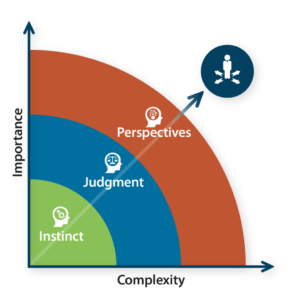The three essential elements of making better decisions
How do some of the world’s most influential CEOs make decisions?
It varies. Jeff Bezos analyzes decisions from the point of view of his future self. WPP’s Sir Martin Sorrell prefers to gather insights from a diverse group of people and create a “balance sheet” before making a decision. Meanwhile, veteran CEO Lars Rebien Sørenson tries to consider both qualitative and quantitative variables, such as financial metrics and company values, when faced with a tough choice.
In spite of their decision-making differences, these CEOs share something in common: They deliberately apply a decision-making process that is conscious, rigorous and entirely unique to them as individuals.
Data from Vistage Research indicates that’s no accident—and that it doesn’t just apply to big-name CEOs from large, complex organizations. After spending years studying the decision-making practices of CEOs from high-growth, small and midsize businesses across diverse industries and geographies, we’ve found that the best-performing companies are led by CEOs who have a thoughtful and conscious approach to decision-making. We’ve also found that these top decision-makers integrate instinct, judgment and perspectives when making a complex, high-stakes decision. This core competency leads to what we call “Optimized Decision Making” (Figure 1).

Here’s how these three elements work in practice, and how you can use them to build and optimize your decision-making process.
From integration to optimization
For the sake of clarity, let’s explore the different roles of instinct, judgment and perspectives in the decision-making process.
- Instinct is your gut reaction to a situation or stimulus.
- Judgment is about applying data and experience to analyze a situation.
- Perspectives is about seeking external expertise that can expand, influence or change your point of view.
There’s a correlation between the importance or complexity of a decision, and the value of applying instinct, judgment and perspectives to your decision-making process. When you’re facing a simple decision (e.g., ordering office supplies), you only need instinct to arrive at an answer. For more complex decisions (e.g., making a new hire), instinct plus judgment can lead you to a good choice. In the case of complex, high-stakes decisions (e.g., entering a new market), it’s best to integrate instinct, judgment and perspectives.
Integration doesn’t mean adding these variables together. It means allowing for constant interplay between different or opposing ideas, opinions and directions; it means negotiating between your gut and brain, data and opinion, your views and others’ views. Reaching this state requires discipline, self-awareness, vulnerability and an openness to new ideas. It can be helpful to ask yourself questions such as, how strongly do I believe what my gut is telling me? How much weight should I place in my own experiences versus those of others? To what degree do I know—or don’t know—what I don’t know?
CEOs are in the business of making decisions, and this process sets you up to make better ones. However, mistakes happen. If you end up making a bad choice, use it as an opportunity to improve your judgment and draw from the experience next time you have to make a decision. Regardless, have the confidence to say: I applied a thoughtful process to this decision. I made the best choice with the information that I had. And if I commit to this decision-making process, it will ultimately lead to better outcomes for my organization.
This article was originally published in Inc. Magazine
Read more on this topic: The major growth decisions facing CEOs
Category: Leadership
Tags: CEO leadership, Decision Making

